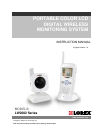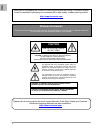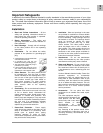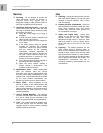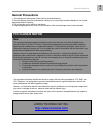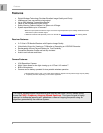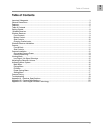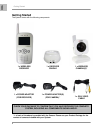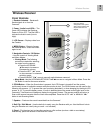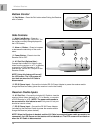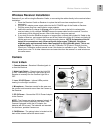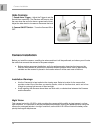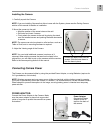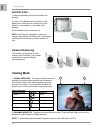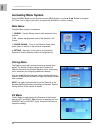
Wireless Receiver
9
ENG
Wireless Receiver
Front Controls
1. Receiver Antenna – Receives &
Sends signals to or from the
Cameras*
2. Power / Audio Level LEDs – The
Green LED indicates the Receiver
Power is ON or OFF. The Red LED’s
indicate the Audio Levels (Low to
High).
3. LCD Screen – Displays video from
the Camera.
4. MENU Button – Press to Access
the Receiver Menu. Press the button
again to exit.
5. Navigation Controls / OK Button
– Use the controls in Viewing Mode
and Menu Modes:
• Viewing Mode: The following
controls are used while watching
live video from the camera:
o Press the UP/DOWN
▲▼arrows to Increase or
Decrease the volume.
o Press the LEFT “◄A” arrow
to view cameras* in automatic
switching mode.
o Press the RIGHT “M►” arrow to manually switch between cameras*.
• Menu Mode: Use the UP/DOWN/LEFT/RIGHT ▲▼◄► arrows to navigate in Menu Mode. Press the
OK Button to confirm the menu selection.
6. SCAN Button – When the Scan button is pressed, the LCD Screen is turned off and the system
continuously scans all available cameras while the monitor is dark. The SCAN feature can be used for the
following two reasons: (1) To prevent the user from being disturbed (i.e. when sleeping) by the bright LCD
screen, or (2) To conserve battery power. If audio is detected above the preset audio trigger level on the
Camera(s)*, the Receiver will beep and display the triggered Camera. The camera receiver will return to
Scan mode several seconds after the Alarm has completed. Press the AUTO “◄A” or MANUAL “M►”
button to exit Scanning Mode.
7. Speaker – Produces the sound transmitted from the Cameras*.
8. Belt Clip / Wall Mount – Use the belt clip to easily carry the Receiver with you. Use the Mount hole to
hang the Receiver on a wall (using a screw – not included).
9. Stand – Flip the stand out to place the receiver on a flat surface (such as a table or countertop).
Alternatively, place the receiver in the Receiver Cradle.
1
2
3
6
7
4
5
* You must have more
than one camera
configured on the system
when using functions that
require more than one
camera.
8
9



